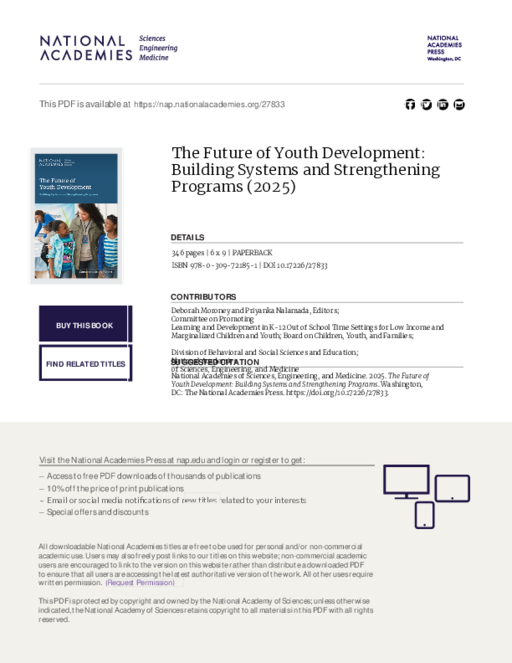Back to Overview
The Future of Youth Development
Table of Contents
- Author(s)
- Deborah Moroney and Priyanka Nalamada
- Publisher(s)
- The National Academies of Sciences, Engineering, and Medicine
Page Count
346 pages
- DOI Link
- https://doi.org/10.17226/27833
Implementation Tips
The report offers a series of recommendations across six goal areas for federal, state, and local stakeholders and funders to strengthen OST programs. These recommendations include:
- Supporting stable OST funding
- Funders could consider providing long-term, flexible funding for OST programs, covering staff pay, operating costs, and evaluations to ensure sustainability and growth.
- Funders could consider streamlining grant processes and coordinate funding to ease administrative burdens on OST programs.
- Funders could consider aligning funding priorities with youth development needs and engage communities in designing funding opportunities.
- Dedicated funding could help reduce participation barriers by covering transportation, financial incentives, culturally relevant programs, and outreach efforts.
- Supporting local intermediaries
- Government and philanthropic funders could consider providing sustained funding for intermediaries that support OST programs.
- Public funders could consider prioritizing partnerships with local intermediaries for grant allocation and quality improvement support.
- Where no coordinating body exists, governments could consider establishing or supporting intermediaries to enhance OST program coordination.
- Local intermediaries could consider assessing and addressing gaps in OST program access using data-driven tools.
- Advancing program quality
- Funders could consider supporting quality improvement efforts, including technical assistance and capacity building for data use.
- Local intermediaries could consider regularly reviewing and updating program quality initiatives based on research and community needs.
- Intermediaries could consider collaborating with schools, universities, and agencies to share data for program improvement while maintaining clear data-sharing agreements.
- Supporting youth development practitioners
- Funders could consider investing in workforce development to strengthen career pathways for OST practitioners.
- Colleges and universities could consider expanding coursework and practical experiences in youth development.
- The Office of Management and Budget could consider creating a standard occupational classification for OST practitioners to enhance workforce research.
- Broadening understanding of OST programs
- Federal agencies could consider supporting ongoing research to track OST program supply, demand, and participation.
- Government agencies should consider collecting and publicly sharing data on OST participation, considering a variety of demographic factors.
- Improving understanding of program outcomes
- Funders could consider supporting rigorous research on OST program effectiveness—across a wide range of short- and long-term outcomes—as well as studies that include measures of participation, program duration, program quality, and implementation.
Topics:

